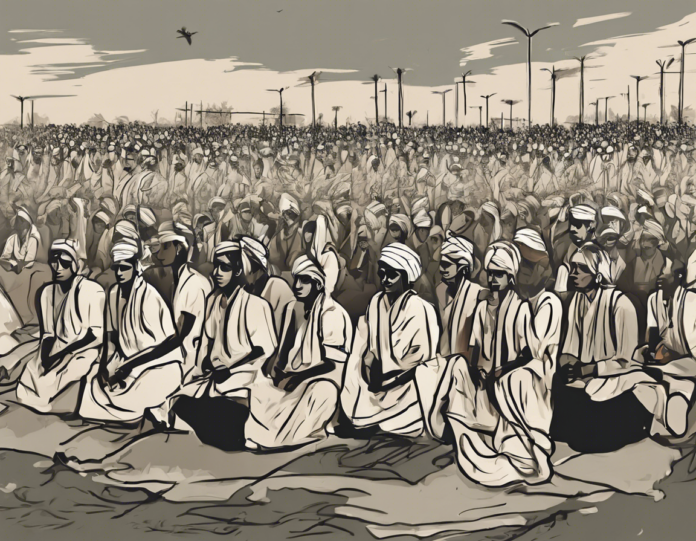Introduction
The Narmada Bachao Andolan (NBA), which translates to ‘Save the Narmada Movement’ in English, is a social movement that originated in the early 1980s in India. The movement is primarily focused on the issues surrounding the construction of large dams on the Narmada River, one of the largest westward-flowing rivers in India. The NBA advocates for the rights of the local communities, environmental protection, and sustainable development in the Narmada River valley. This article will delve into the environmental impact of the Narmada Bachao Andolan movement and its significance in the context of sustainable development.
Background of the Narmada Bachao Andolan Movement
The roots of the NBA can be traced back to the 1960s when the Indian government proposed the construction of large dams on the Narmada River as part of the Narmada Valley Development Project. The project aimed to harness the water resources of the Narmada River for irrigation, hydroelectric power generation, and water supply to drought-prone regions.
The construction of the Sardar Sarovar Dam, one of the key projects under the Narmada Valley Development Project, faced vehement opposition from environmentalists, social activists, and local communities. The NBA, led by social activist Medha Patkar, emerged as a prominent voice against the displacement of thousands of indigenous people and the adverse environmental impact of the dam projects.
Environmental Impact of Large Dams
-
Displacement of Communities: One of the primary concerns raised by the NBA is the displacement of indigenous communities due to the construction of large dams. The reservoir created by the dam leads to submergence of vast areas of forest land, agricultural fields, and villages, resulting in the displacement of local communities.
-
Ecological Damage: Large dams have a significant impact on the ecological balance of river ecosystems. The altered flow of the river, changes in water temperature, and loss of habitat due to submergence can lead to the decline in biodiversity, affecting the flora and fauna of the region.
-
Water Quality: The impoundment of water behind dams can lead to stagnation, reduced oxygen levels, and accumulation of pollutants, impacting the water quality of the river. This can have detrimental effects on aquatic life and human communities depending on the river for drinking water and livelihoods.
-
Sedimentation: Dams disrupt the natural flow of sediments downstream, leading to sedimentation within the reservoir and downstream riverbed. This can affect nutrient cycling, erosion control, and the health of aquatic ecosystems in the long run.
-
Climate Change Resilience: Large dams can have complex implications for climate change resilience. While they can contribute to mitigating floods and providing water for irrigation during droughts, they can also exacerbate the impacts of climate change by altering natural river flows and ecosystems.
Significance of the Narmada Bachao Andolan Movement
-
Indigenous Rights: The NBA has been instrumental in advocating for the rights of indigenous communities affected by large dam projects. It emphasizes the need for free, prior, and informed consent of the local communities before the implementation of development projects in their territories.
-
Environment Conservation: By highlighting the adverse environmental impacts of large dams, the NBA has drawn attention to the importance of sustainable development practices that prioritize environmental conservation and ecosystem protection.
-
Alternative Development Models: The NBA promotes alternative development models that are socially just, environmentally sustainable, and respectful of indigenous knowledge and rights. It advocates for decentralized, small-scale solutions that prioritize community participation and empowerment.
-
Policy Advocacy: Through its campaigns and advocacy efforts, the NBA has influenced policy decisions at the national and international levels regarding the construction of large dams and the rights of indigenous communities. It has been instrumental in shaping discourse on environmental justice and sustainable development.
Frequently Asked Questions (FAQs)
-
What are the main objectives of the Narmada Bachao Andolan movement?
The NBA aims to protect the rights of indigenous communities, advocate for environmental conservation, promote sustainable development practices, and oppose the construction of large dams on the Narmada River. -
How has the NBA impacted the lives of local communities in the Narmada Valley?
The NBA has raised awareness about the displacement of indigenous communities, highlighted environmental concerns, empowered local communities to assert their rights, and promoted alternative development models that prioritize sustainability and social justice. -
What are some of the key challenges faced by the NBA in its advocacy efforts?
The NBA faces challenges such as government indifference, lack of adequate resources, legal hurdles, and opposition from vested interests that benefit from large dam projects. Maintaining public support and sustaining momentum for the movement are also ongoing challenges. -
How does the NBA collaborate with other social and environmental movements in India?
The NBA collaborates with other social and environmental movements in India through joint campaigns, solidarity actions, advocacy networks, and collective platforms that aim to address common issues related to environmental justice, human rights, and sustainable development. -
What are the long-term implications of the Narmada Bachao Andolan movement on environmental policy in India?
The NBA has catalyzed discussions on environmental policy in India, influenced decision-making processes regarding large dam projects, and set precedents for incorporating social and environmental considerations into development planning. It continues to be a strong voice for environmental justice in the country.
Conclusion
The Narmada Bachao Andolan movement serves as a testament to the power of grassroots activism in advocating for environmental protection, indigenous rights, and sustainable development. By highlighting the environmental impacts of large dams and promoting alternative development models, the NBA has inspired a broader discourse on environmental justice in India and beyond. As the movement continues its struggle to safeguard the Narmada River and its communities, its impact resonates far beyond the confines of the valley, shaping policies, practices, and perspectives on sustainable development for the future.









